The island (also called St Barth and St Barts) is named after Christopher Columbus’s younger brother. The main town on the island is Gustavia.
We really liked Gustavia in the off season. Here are some reasons why:
Rock-star parking
When we visited before in the high season, the inner harbour was full of mega yachts and we had to anchor way out. This time, Tony motored us into the inner harbour and we looked for a mooring ball until an official in a zodiac came to us. After chiding us for not calling ahead, he told us to side-tie at the government dock.
It was so convenient to be right in town and near the clean public facilities too! The price was surprisingly reasonable — we decided to stay three nights. It was lovely to be off the boat and into town whenever we liked — no need to dinghy in and risk wet-butt.
French food
We had delicious French food, professionally served in attractive cafes and restaurants. Highlights were crepes Breton, euro-style pizza, and the best was dinner at Bonito — a beautiful restaurant overlooking the harbour. Daniella’s father lives on St. Barts and she asked him for a recommendation: Bonito was the top of his list.
Bonito was well worthy of Tony Day’s birthday meal (albeit a few days late). He kicked it off with an innovative rum cocktail served under a cloche filled with sage-scented smoke. The meal carried on delightfully from there. Everyone at the restaurant appeared to be “someone”. I think that we must have looked like “someone” also because when the diner at the next table got up to video his party, he quietly captured each one of us on video too.
Le Shopping
St. Barts is a high-end shopper’s dream. Gayle, our shopping expert says of Barts:
A combination of Laguna Beach, Beverly Hills (the classic part) and Hayes Valley. The art was iffy, but the jewelry and fashion and decor were so luxurious. Also, French women don’t wear baseball caps. Just so you know.
I enjoyed shopping at the grocery store; in particular we stocked up on wine and got some yummy French cheese too.
People
All the people we met were appropriately pleasant and helpful (and not obsequious).
- The chandlery stayed open an extra 10 minutes to help with our pump problem.
- The harbour staff tried to appear officious but were very helpful and service oriented.
- The quirky lady at the sandwich shop made us laugh.
- Gayle and Pete enjoyed chatting to the shop girl just back from two years of travel.
- The clerk in the post office spoke enough English but the next day allowed me to complete my transaction in French.
History
I enjoyed learning a bit of island history. I did not know that Sweden had had a Caribbean colony for nearly 100 years; France didn’t get St. Barts (back) until 1878. I did a self-guided walking tour; I liked the plain, solid architecture of the Swedish-built structures.
- Our rock-star parking was very handy to Tom’s grocery store. Here we are leaving the store with our groceries in the “chariot” (that’s French for shopping cart / trolley).
- 15 seconds later, here we are with our chariot next to On Delay.
- St. Barts has duty free shopping. Just 2 euros for the bottle of Barcardi O on the right. If we don’t care to drink it, we can use it to kill the fish speared by Pete.
- This is the Dinezy House. Built in 1820. It is a fine example of a merchant house during the Swedish period. The first storey is in stone and second is in wood. (Evidently, this is similar to houses in Gothenberg; better than all-wood houses for resisting fire — and wave damage during hurricanes.)
- All the streets in the center of Gustavia have two names: A French name and a Swedish name.
- Also from this Swedish period, a two story building, built to be used as a school. Started in 1800 and completely 1804. Also used as a meeting house, a prison, a canteen and a government administration building.
- The Swedish bell tower, built in 1799 and rebuilt after hurricane damage in 1837.
- A photo of On Delay in her rockstar parking spot.
- Notre Dame de l’Assumption built in 1829 and renovated after hurricane damage in 1837. Foundations are more than 2 meters to mitigate damage by waves during hurricanes. Architecture is Spanish influenced, making this an unusual church in the French West Indies.
- The bell tower of the Catholic church. It is separate from the church because of hurricanes: This way if the bell tower topples, the church is not damaged and vice versa.
- The Anglicans have a solid little church right on the main harbour. It was built in 1855.
- This is the walking path up to Fort Karl.
- Another view of On Delay from the far side of the harbour.
- The view from Fort Karl. (Built in 1789 and named after Gustav III’s brother, Duke Karl.)
- A view over Gustavia from Fort Karl. On Delay is in this photo too!
- One aspect of the rockstar parking is accessibility to the facilities. Here, Tony, wearing his Marks & Spencer dressing gown, heads off to shower.
- We had a lovely dinner at this restaurant overlooking the harbour. We would never have found it ourselves; Daniella (tenant #62) asked her dad for recommendations. He lives on St Barts and obviously has good taste in restaurants.
- Pete and Gayle: First breakfast in Gustavia at La Petite Colombe Patisserie.
- Tony and Jane: Pain au chocolate for me.
- One of the many tasty French meals we enjoyed. This is lunch at the resto under the chandlery.
- Gayle took this beautiful series of flower portraits in Gustavia.
- Jane and flowers in St. Barts. Photo by Gayle.

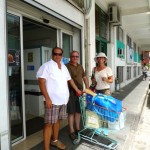
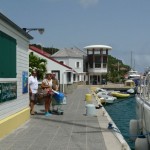
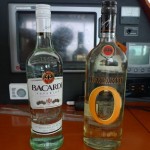
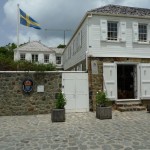
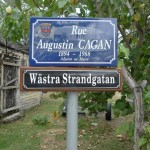
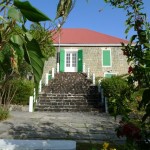
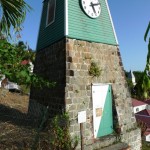
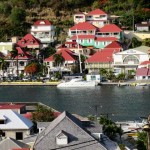
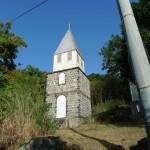
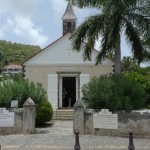
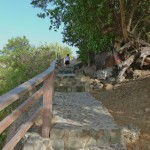
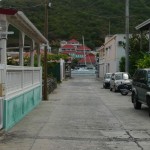
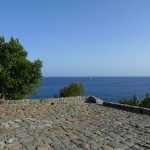
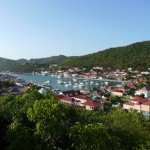
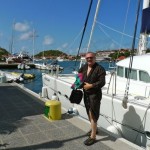
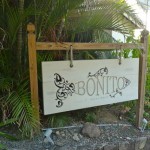
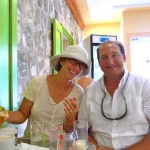
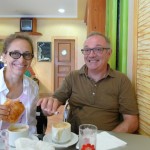
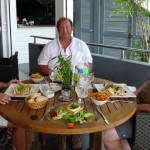
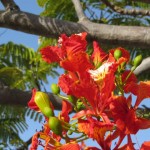
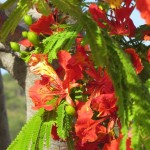
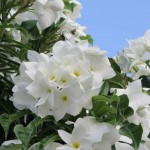
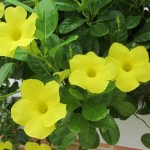

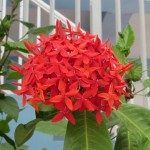
Happy Birthday, to Tony! Hope it was happy! From Pat and Geoffrey